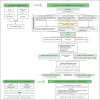Systematic druggable genome-wide Mendelian randomization identifies therapeutic targets for sarcopenia
- PMID: 38644354
- PMCID: PMC11294052
- DOI: 10.1002/jcsm.13479
Systematic druggable genome-wide Mendelian randomization identifies therapeutic targets for sarcopenia
Abstract
Background: There are no effective pharmacological treatments for sarcopenia. We aim to identify potential therapeutic targets for sarcopenia by integrating various publicly available datasets.
Methods: We integrated druggable genome data, cis-eQTL/cis-pQTL from human blood and skeletal muscle tissue, and GWAS summary data of sarcopenia-related traits to analyse the potential causal relationships between drug target genes and sarcopenia using the Mendelian Randomization (MR) method. Sensitivity analyses and Bayesian colocalization were employed to validate the causal relationships. We also assessed the side effects or additional indications of the identified drug targets using a phenome-wide MR (Phe-MR) approach and investigated actionable drugs for target genes using available databases.
Results: MR analysis identified 17 druggable genes with potential causation to sarcopenia in human blood or skeletal muscle tissue. Six of them (HP, HLA-DRA, MAP 3K3, MFGE8, COL15A1, and AURKA) were further confirmed by Bayesian colocalization (PPH4 > 90%). The up-regulation of HP [higher ALM (beta: 0.012, 95% CI: 0.007-0.018, P = 1.2*10-5) and higher grip strength (OR: 0.96, 95% CI: 0.94-0.98, P = 4.2*10-5)], MAP 3K3 [higher ALM (beta: 0.24, 95% CI: 0.21-0.26, P = 1.8*10-94), higher grip strength (OR: 0.82, 95% CI: 0.75-0.90, P = 2.1*10-5), and faster walking pace (beta: 0.03, 95% CI: 0.02-0.05, P = 8.5*10-6)], and MFGE8 [higher ALM (muscle eQTL, beta: 0.09, 95% CI: 0.06-0.11, P = 6.1*10-13; blood pQTL, beta: 0.05, 95% CI: 0.03-0.07, P = 3.8*10-09)], as well as the down-regulation of HLA-DRA [lower ALM (beta: -0.09, 95% CI: -0.11 to -0.08, P = 5.4*10-36) and lower grip strength (OR: 1.13, 95% CI: 1.07-1.20, P = 1.8*10-5)] and COL15A1 [higher ALM (muscle eQTL, beta: -0.07, 95% CI: -0.10 to -0.04, P = 3.4*10-07; blood pQTL, beta: -0.05, 95% CI: -0.06 to -0.03, P = 1.6*10-07)], decreased the risk of sarcopenia. AURKA in blood (beta: -0.16, 95% CI: -0.22 to -0.09, P = 2.1*10-06) and skeletal muscle (beta: 0.03, 95% CI: 0.02 to 0.05, P = 5.3*10-05) tissues showed an inverse relationship with sarcopenia risk. The Phe-MR indicated that the six potential therapeutic targets for sarcopenia had no significant adverse effects. Drug repurposing analysis supported zinc supplementation and collagenase clostridium histolyticum might be potential therapeutics for sarcopenia by activating HP and inhibiting COL15A1, respectively.
Conclusions: Our research indicated MAP 3K3, MFGE8, COL15A1, HP, and HLA-DRA may serve as promising targets for sarcopenia, while the effectiveness of zinc supplementation and collagenase clostridium histolyticum for sarcopenia requires further validation.
Keywords: Colocalization; Druggable genes; Mendelian randomization; Sarcopenia.
© 2024 The Authors. Journal of Cachexia, Sarcopenia and Muscle published by Wiley Periodicals LLC.
Conflict of interest statement
The authors declare that there is no conflict of interest.
Figures


References
-
- Patel HP, Syddall HE, Jameson K, Robinson S, Denison H, Roberts HC, et al. Prevalence of sarcopenia in community‐dwelling older people in the UK using the European Working Group on Sarcopenia in Older People (EWGSOP) definition: findings from the Hertfordshire Cohort Study (HCS). Age Ageing 2013;42:378–384. - PMC - PubMed
-
- Cruz‐Jentoft AJ, Sayer AA. Sarcopenia. Lancet (London, England) 2019;393:2636–2646. - PubMed
MeSH terms
Grants and funding
- 2022NSFSC0749/National Natural Science Fund of Sichuan
- 2023HXFH032/135 Project for Disciplines of Excellence-Clinical Research Fund, West China Hospital, Sichuan University
- 2022YFC2703101/National Key Research and Development Program of China
- 2023YFS0269/Science and Technology Bureau Fund of Sichuan Province
- 81971188/National Natural Science Fund of China
LinkOut - more resources
Full Text Sources
Other Literature Sources
Research Materials
Miscellaneous

